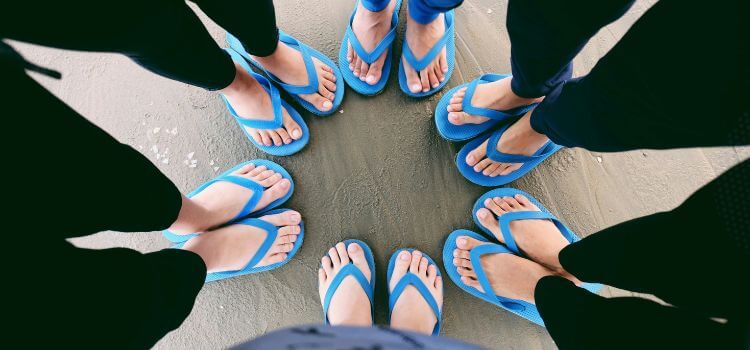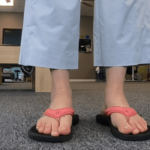As an Amazon Associate I earn from qualifying purchases.

Are you tired of your flip-flops constantly slipping off or feeling too loose? Don’t worry; we’ve got you covered. This detailed guide will walk you through practical steps to make your flip-flops fit tighter for maximum comfort and stability.
Understanding the Importance of a Snug Fit
When it comes to footwear, the most important thing to consider is comfort. Additionally, getting the ideal fit for flip-flops is crucial for their practicality and comfort.
A tight fit lowers the possibility of blisters, slips, and discomfort by keeping your feet stable and supported. But what can you do if your flip-flops are feeling a bit loose? Fear not, because several simple yet effective methods exist to make your flip-flops fit tighter
Identifying the Issue
It’s important to first understand the typical problems that can occur when flip-flops don’t fit correctly before moving on to the solutions:
1. Loose Straps
One of the most common problems with flip-flops is loose straps. Over time, the straps may stretch out, causing the flip-flops to feel floppy and insecure on your feet.
2. Wide Gaps
Another issue is the wide gaps between the straps and your feet. This gap can lead to instability and discomfort while walking, as your feet may slide around too much.
3. Lack of Arch Support
Some flip-flops may also lack adequate arch support, which can contribute to a loose and unsupportive fit. Without enough support, your feet could become tired more quickly and experience greater pain and strain.
How Should Flip Flops Fit
Now that we’ve identified the common issues, let’s explore some effective solutions to make your flip-flops fit tighter:
1. Adjusting Straps for a Custom Fit
Step-by-Step Strap Adjustment
- Step 1: Identify loose straps
- Step 2: Utilize heat to soften straps
- Step 3: Adjust straps to desired tightness
- Step 4: Let straps cool and set in the new position
2. Add Inserts or Cushions
To fill in wide gaps and provide extra support, consider adding inserts or cushions to your flip-flops. There are various types of inserts available, including gel pads, foam cushions, and arch supports, all designed to enhance comfort and stability. Place the inserts under the straps or in the footbed of your flip-flops for added support and a tighter fit.
3. Use Toe Grips
Toe grips are small adhesive pads that adhere to the underside of your flip-flops, providing extra traction and grip for your toes. By preventing your toes from sliding forward, toe grips can help create a tighter and more secure fit. Simply apply the toe grips to the underside of the footbed, positioning them near the front edge where your toes rest.
4. Try Sock Liners
For flip-flops that lack arch support, sock liners can be a game-changer. Sock liners are thin, breathable socks worn underneath flip-flops, providing additional cushioning and support for your feet. Not only do sock liners improve comfort, but they also help create a snugger fit by filling in any gaps between your feet and the footbed.
5. Replace Worn-Out Flip Flops
If your flip-flops are old and worn out, it may be time to invest in a new pair. Over time, the materials in flip-flops can degrade, causing them to lose their shape and support. By replacing your worn-out flip-flops with a new pair, you can ensure a snugger fit and better overall comfort.
Using Insoles for Extra Support
Selecting the Right Insoles
- Consider gel insoles for added comfort
- Opt for insoles with arch support for enhanced stability
- Ensure insoles fit seamlessly in your flip-flops
Choosing the Right Flip-Flops
Choosing the suitable flip-flops involves considering both style and functionality. When selecting flip-flops, comfort should come first to ensure a comfortable walking experience. Choose shoes with supportive arches and padded soles, particularly if you want to wear them all day.
Additionally, consider the material of the straps to avoid discomfort or blisters. Durability is another crucial factor, so opt for flip-flops with sturdy construction and quality materials that can withstand various terrains.
Personal preferences also come into play, as there are a variety of designs, hues, and patterns to choose from. Whether you prioritize a casual beach look or a more polished appearance, choose flip-flops that align with your style.
Lastly, check for sizing accuracy to guarantee a snug fit, preventing any potential discomfort or accidents while walking. Considering these factors ensures you select the suitable flip-flops that look good and provide the comfort and durability needed for your activities.
Finding the Perfect Fit from the Start
When choosing flip-flops, it’s crucial to prioritize comfort and sizing accuracy to find the perfect fit from the start. Consider characteristics like cushioned soles, arch support, and sturdy materials. To avoid discomfort or mishaps, make sure the fit is snug. Additionally, consider your style preferences to make a well-rounded choice.
Considerations When Purchasing Flip Flops
- Material matters: Choose flip-flops with adjustable straps
- Size up if in doubt: Slightly larger flip-flops can be adjusted for a better fit
- Opt for contoured footbeds for improved support
Cleaning and Inspecting Your Flip Flops
- Regularly clean straps to prevent dirt accumulation
- Inspect soles for wear and tear
- Replace worn-out flip-flops for continued comfort
Conclusion
In conclusion, achieving a tighter fit for your flip-flops is possible and essential for a comfortable and enjoyable experience. Following our comprehensive guide, you can customize your flip-flops to fit your unique needs, ensuring that each step is confident and secure.
Don’t let loose flip-flops keep you from enjoying sunny days and leisurely walks. Take control of your footwear comfort today by applying these practical tips. Remember that even minor adjustments can significantly improve your flip-flop pleasure.
Amazon and the Amazon logo are trademarks of Amazon.com, Inc, or its affiliates.




Leave a Reply